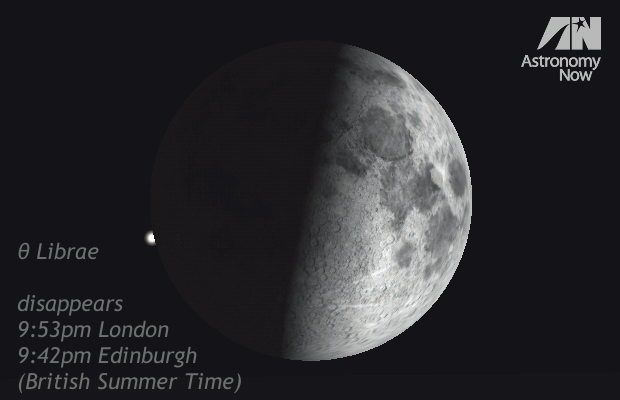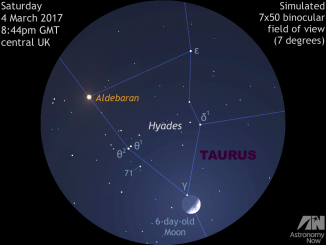
There are two other reasons why I wish you to take a good look at the Moon on the night of 22 August 2015. Starting around 45 minutes after sunset (which is about 9:10pm for the centre of the UK; you may use our Almanac to calculate times for your nearest city), when the twilight has darkened sufficiently, binoculars will reveal a 1st-magnitude ‘star’ two degrees (the width of a thumb at arm’s length) to the lower right of the half Moon. Even the smallest telescope at 20x magnification or more will reveal this ‘star’ to be ringed planet Saturn.
By 9:30pm, keen-eyed binocular users with a clear sky will notice a star near the darkened lunar hemisphere, one that is getting closer to the Moon with each passing minute. This is magnitude +4.1 star theta (θ) Librae, and it will shortly be covered by the Moon in an event known as an occultation.
While you may have success using 10x magnification binoculars (10×50, 10×40, etc.) to witness the star’s disappearance — particularly if you can steady your view by leaning your elbows on a low wall or fence — a telescope on an accurately tracking mount will be your best bet if you wish to see θ Librae reappear at the bright limb of the Moon a little over an hour later.
The reapparance of θ Librae will be complicated by the Moon’s very low altitude, so you will need a viewing location with a level and unobscured southwestern horizon. As seen from London, it will occur close to 10:52pm; in Edinburgh it happens around 10:45pm. For the centre of the British Isles, the star pops back into view close to 10:48pm. Clear skies!.
Inside the magazine
You can find out more about observing the Moon and planets in the August edition of Astronomy Now in addition to a full guide to the night sky.
Never miss an issue by subscribing to the UK’s biggest astronomy magazine. Also available for iPad/iPhone and Android devices.




